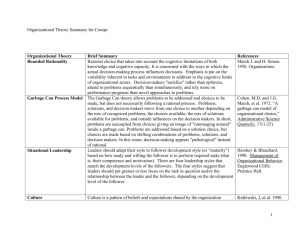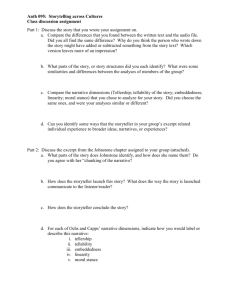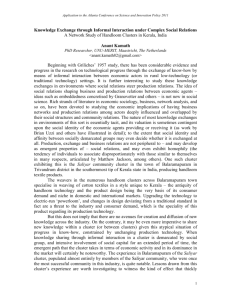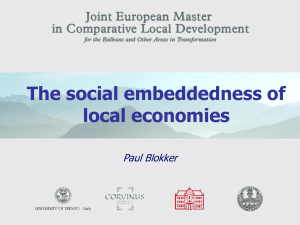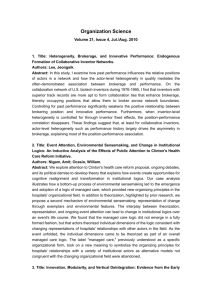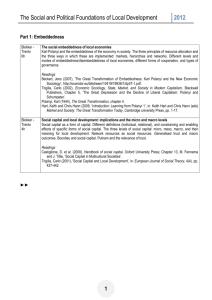A UMI Dissertation
advertisement
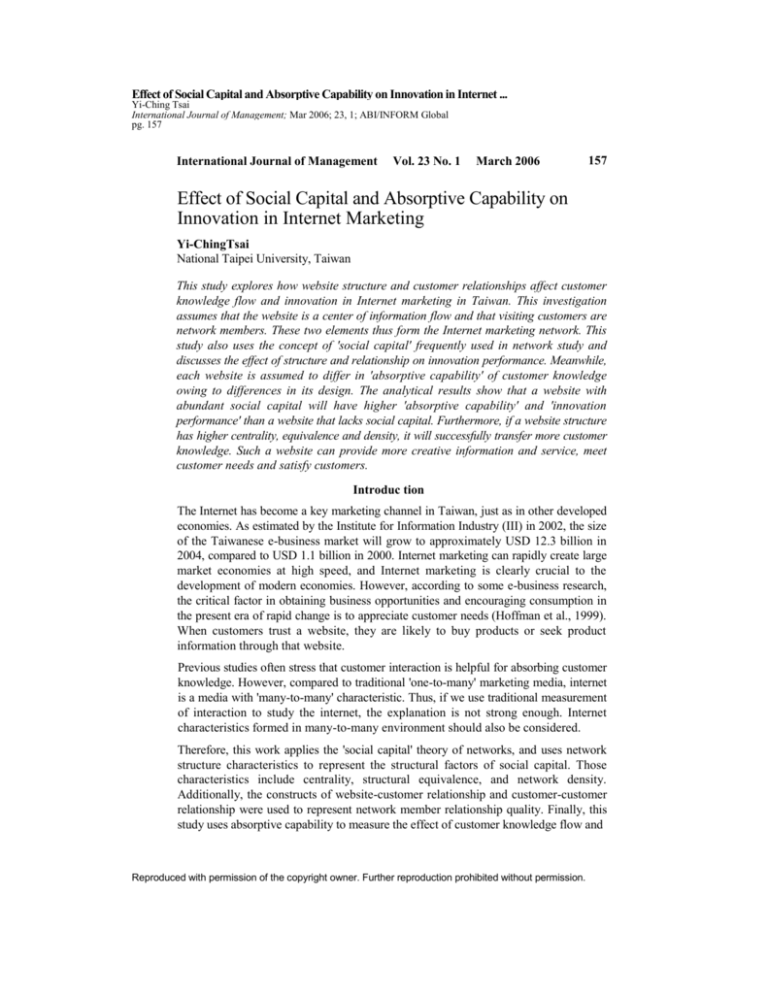
Effect of Social Capital and Absorptive Capability on Innovation in Internet ... Yi-Ching Tsai International Journal of Management; Mar 2006; 23, 1; ABI/INFORM Global pg. 157 International Journal of Management Vol. 23 No. 1 March 2006 157 Effect of Social Capital and Absorptive Capability on Innovation in Internet Marketing Yi-ChingTsai National Taipei University, Taiwan This study explores how website structure and customer relationships affect customer knowledge flow and innovation in Internet marketing in Taiwan. This investigation assumes that the website is a center of information flow and that visiting customers are network members. These two elements thus form the Internet marketing network. This study also uses the concept of 'social capital' frequently used in network study and discusses the effect of structure and relationship on innovation performance. Meanwhile, each website is assumed to differ in 'absorptive capability' of customer knowledge owing to differences in its design. The analytical results show that a website with abundant social capital will have higher 'absorptive capability' and 'innovation performance' than a website that lacks social capital. Furthermore, if a website structure has higher centrality, equivalence and density, it will successfully transfer more customer knowledge. Such a website can provide more creative information and service, meet customer needs and satisfy customers. Introduc tion The Internet has become a key marketing channel in Taiwan, just as in other developed economies. As estimated by the Institute for Information Industry (III) in 2002, the size of the Taiwanese e-business market will grow to approximately USD 12.3 billion in 2004, compared to USD 1.1 billion in 2000. Internet marketing can rapidly create large market economies at high speed, and Internet marketing is clearly crucial to the development of modern economies. However, according to some e-business research, the critical factor in obtaining business opportunities and encouraging consumption in the present era of rapid change is to appreciate customer needs (Hoffman et al., 1999). When customers trust a website, they are likely to buy products or seek product information through that website. Previous studies often stress that customer interaction is helpful for absorbing customer knowledge. However, compared to traditional 'one-to-many' marketing media, internet is a media with 'many-to-many' characteristic. Thus, if we use traditional measurement of interaction to study the internet, the explanation is not strong enough. Internet characteristics formed in many-to-many environment should also be considered. Therefore, this work applies the 'social capital' theory of networks, and uses network structure characteristics to represent the structural factors of social capital. Those characteristics include centrality, structural equivalence, and network density. Additionally, the constructs of website-customer relationship and customer-customer relationship were used to represent network member relationship quality. Finally, this study uses absorptive capability to measure the effect of customer knowledge flow and Reproduced with permission of the copyright owner. Further reproduction prohibited without permission. 158 International Journal of Management Vol. 23 No. 1 March 2006 adopts the concepts of 'social capital' and 'absorptive capability' to discuss the influences of the concepts of 'social capital' and 'absorptive capability' on website innovation performance. Literature Review Previously, most researchers considered economic behavior to be constrained by continuing social connections. From the perspective of social structure, Burt (1992), Nahapiet and Ghoshal (1988) think all people should participate in a society in which there are shared norms and established social structures, relational and institutional embeddedness. Under such conditions, they can create common social wealth and values. Individuals intending to break or exit the connections would affect the productivity of others to create value. Furthermore, those objects that are embedded in social structure, institution and relationships are termed 'social capital'. Nahapiet and Ghoshal defined the structural dimension of social capital as the 'holistic connection pattern among members'. In this dimension, important constructs used in previous researches including network connections among members, network structure and morphology. The criteria used for measuring the connection pattern include density, connectivity and level. Nahapiet and Ghoshal also integrated previous studies and pointed out that social capital should include structural and relational dimensions. Granovetter (1985) divided social capital into structural embeddedness and relational embeddedness dimensions. Granovetter also argued that website structure will improve relationships among members with better structures. Therefore, structural embeddedness positively affects relational embeddedness. On the basis of the above considerations, the following hypothesis is proposed: H1: Structural embeddedness positively affects relational embeddedness. Structural Embeddedness Granovetter (1992) noted that structural embeddedness includes social system and overall relational network characteristics. Structural embeddedness could be defined as the impersonal connection structure among people or units. This study defines structural embeddedness in accordance with the proposals of Davi and Ravindranath (2001). The measurement of structural embeddedness includes centrality, structural equivalence and network density. Structural embeddedness provides network members with more efficient information flow (Jones et al., 1997). Centrality of structural embeddedness refers to individual positioning in the Internet, and also ensures that the connection is meaningful (Wasserman and Faust, 1994). Higher centrality implies more important status and power (Wasserman and Faust, 1994), more resources (Brass and Burkhardt, 1992) and more rapid resource flow (Gnyawali and Madhavan, 2001), as well as easy information receipt and update. This investigation Reproduced with permission of the copyright owner. Further reproduction prohibited without permission. International Journal of Management Vol. 23 No. 1 March 2006 159 uses the ability to control information flow in a website environment and customer trust in the website for measuring centrality. Structural equivalence measures partnership among network members. Information exchange among members becomes closer with increasing structural equivalence. A website manager can build equivalence among network members, to make the status of members more equal, and also to control the information exchange among network members (Roger, 1995). Additionally, network managers with higher centrality can increase network member numbers (Gulati, 1995), namely, enhance network density. In this study, network density means the numbers of customers in a website, and also describes the percentage of customers who really provide information, compared to those who do not give any information. Previous structural embeddedness-related papers pointed out that structural embeddedness affects organizational absorptive and innovative capability (Chen and MacMillan, 1992; Ferrier et al., 1999). On the basis of the above considerations, the following hypotheses are proposed: H2: Structural embeddedness positively affects absorptive capability. H3: Structural embeddedness positively affects innovation performance. Relational Embeddedness The concept of relational embeddedness was originally used in communication studies. This concept was used to describe the phenomenon of one-to-one resource distribution. Subsequently, this concept was gradually applied in intra-organization or betweenorganization studies (Burt, 1992). Some authors also pointed out that relational embeddedness significantly affects competitive advantages (Dyer, 1998). 'Relational embeddedness' describes interpersonal relationship developed by interpersonal interactions during a specific period (Granovetter, 1992). Nahapiet and Ghoshal (1998) defined the relational dimension of social capital as 'the asset created and used through relationship.' In this dimension, previous studies have used important constructs like trust, trustworthiness, norm, sanction, obligation and expectation, identity and identification to study relational embeddedness. This study defines customer network connection as a connection among customers who provide a website with information or knowledge (McEvily and Zaheer, 1999; Uzzi, 1997). Gulati (1998) also mentioned that website participants are inclined to cultivate their shared and mutual understanding behaviors to make such social relationships the consensus. This one-to-one connection is a key for knowledge sharing (Cohen and Levinthal, 1990). Uzzi (1997) noted that under one-to-one relationship, members share their information and suggestions more when the connection is stronger. Therefore, under a strong connection relationship, it is easier to achieve better effects in terms of mutual network learning, adapting to uncertain environments, knowledge flow and innovation. Reproduced with permission of the copyright owner. Further reproduction prohibited without permission. 160 International Journal of Management Vol. 23 No. 1 March 2006 This work divides relational embeddedness into 'website-customer relationships' and 'customer-customer relationships'. Based on the above literature review, the establishment of those two relationships will assist knowledge absorption. First, from the perspective of website-customer relationships, websites with better relationships with customers will attract customer visits and make customers willing to provide varieties of knowledge. Second, from the perspective of customer-customer relationship, customers with better mutual relationships will exchange their opinions easily and extensively. Through group discussions, customers will give opinions related to products or service improvement to the service provider. These feedbacks benefit absorptive capability and innovation performance. Previous papers have observed that relational embeddedness affects organizational absorptive and innovative capability. On the basis of the above considerations, the following hypotheses are proposed: H4: Relational embeddedness positively affects absorptive capability. H5: Relational embeddedness positively affects innovation performance. Absorptive Capability and Innovation Performance Absorptive capability refers to the capability of a business to manage knowledge for customers, that is, the ability to acquire, transfer, update, renew and apply customer knowledge. Absorptive capability is extremely helpful for innovation (Wong, 1995). Cohen and Levinthal (1990) defined absorptive capability as the capability of 'a business' to understand external information value, and to apply it for business innovation.' In this study, website innovation performance measures website innovation in providing service and information. The measurement proposed by Olson et al. (1995), which includes speed of providing information, degree of goal achievement, service quality, customer satisfaction and degree of service success is used to measure website innovation. Absorptive capability not only assists the performance of organizational innovation (Chanaron and Perrin, 1987), but also as a source of sustainable competitive advantage. The influence of absorptive capability is more prominent in the information or technological industries (Bettis and Hitt, 1995; Tushman and Anderson, 1986). On the basis of the above considerations, the following hypotheses are proposed: H6: Absorptive capability positively affects innovation performance. Research Method This study surveyed Internet marketing stores in Taiwan. Items for each concept were developed or borrowed from previous research and modified. The questionnaire can be divided into three parts. The first part includes 15 items and measures social capital. Meanwhile, the second part includes 12 items and measures absorptive capability. Finally, the third part includes five items and measures innovation performance. Respondents rated their perceptions of the items using seven-point Likert-type scales, which range Reproduced with permission of the copyright owner. Further reproduction prohibited without permission. International Journal of Management Vol. 23 No. 1 March 2006 161 from 'strongly agree' to 'strongly disagree'. Developed from the previous literature, items have content validity. Additionally, items also have reliability owing to the result of Cronbach's alpha (all results exceed 0.8). Finally, this research uses LISREL to analyze the data to determine whether the hypotheses are supported. Sampling This survey studies Internet marketing stores in Taiwan. From the book "2003 List of eStores in Taiwan" published by the government, 'Direct transaction with customer' section was selected. The electronic questionnaires were then distributed to 1067 stores. Two hundred and twenty stores returned completed questionnaires. After deleting eight unusable questionnaires, 212 (19.87%) responses were deemed usable. Research Results The relationships between constructs were examined using LISREL, and their results are presented in Fig. 1 and summarized below, with the implications being discussed in the following section. Evidently in Fig. 1, this model fits the data closely: X2 /df =2.422, GFI=0.94, AGFI=0.90, IFI=0.91, CFI=0.96, RMR=0.042. The result demonstrates that the proposed model is supported by empirical data . Figure 1. LISREL Analysis Model for Research Framework (Figures are factor loadings; t > 1.96, *p < 0.05; t > 2.58, **p < 0.01; t > 3.29, ***p < 0.001) X2 73.26 df 30 AVdf GFI 2.422 QM AGFI IFI Q_% CFI RMR a% 0.042 Reproduced with permission of the copyright owner. Further reproduction prohibited without permission. 162 International Journal of Management Vol. 23 No. 1 March 2006 This investigation then more closely examined the relationship between latent independent variables and latent dependent variables in the LISREL model. From the perspective of structural embeddedness, as shown in Fig. 1, structural embeddedness positively affects absorptive capability and innovation performance. The factor loading of structural embeddedness and absorptive capability is 0.8, compared to 0.82 between structural embeddedness and relationship embeddedness. The result shows that network structure significantly influences absorptive capability. Additionally, the factor loading of structural embeddedness and innovation performance is 0.35, which suggests that improved network structure significantly helps innovation. Relational embeddedness also positively affects absorptive capability, but the factor loading isjustO.01. Relational embeddedness negatively affects innovation performance, but the factor loading is also only -0.01. Obviously, even if relational embeddedness affects absorptive capability and innovation performance, the influence appears to be weak. Compared to structural embeddedness, relational embeddedness appears not to be very helpful for customer knowledge flow and innovation. According to the empirical result, only H5 is not supported; that is, the hypothesis that 'relational embeddedness positively affects innovation performance' is not supported. Table 1 lists the results. Because the whole model includes both measurement and structural models, all parameters are in their standardized form, which ranges between -1 and +1. As shown in Table 1, most hypotheses are supported except H5. The original hypothesis suggested that relational embeddedness positively affects innovation performance, but the result of empirical analysis indicates that the effect is negative. However, if relational embeddedness influences innovation performance through absorptive capability, the effect becomes positive. The explanation could be that relational embeddedness has a more positive effect if it is through the transformation mechanism of absorptive capability. Table 1. Path Analysis of Latent Variables Independent Variables Dependent Variables Dynamic Capability Innovation Performance Effect t Effect t Structural Embeddedness Direct effect 0.80 g -75*** 0.35 3.50*** Indirect effect 0.26 3 39*** Overall effect 0.80 g75*** 0.77 11.66*** Relational Embeddedness Direct effect 0.01 1.97* -0.01 2.59* Indirect effect 0.01 2.71* Overall effect 0.01 1.97* -0.01 2.99* Dynamic Capability Direct effect 0.54 5.89*** Indirect effect Overall effect 0.54 5.89*** (Figures are factor loadings; t>1.96, *p < 0.05; t> 2.58, **p<0.01;t>3.29, ***p< 0.001) Reproduced with permission of the copyright owner. Further reproduction prohibited without permission. International Journal of Management Vol. 23 No. 1 163 March 2006 Based on the above statistical analysis, this study finds that structural and relational embeddedness affects absorptive capability and innovation performance differently. To explain the interactive relationship between social capital and absorptive capability, this investigation applies regression analysis and draws the model relationship as illustrated in Fig.2. Innovation performance increases with increasing structural embeddedness of a website, accompanied by increased absorptive capability. As for relational embeddedness, websites with the higher relational embeddedness and lower absorptive capability will reduce innovation performance. Discussion and Conclusion The question of how a website uses customer manage to innovate and achieve good performance is a crucial one. This study explores the social capital that resides in websites and discusses its influence on customer knowledge flow in the context of Taiwanese Internet stores. The best answer to the above question appears to be 'to ensure a good structural network and absorptive capability'. First, in the dimension of structural network, this study assumes the website to be the center of the network of information flows between customers. The empirical data demonstrates that websites with higher centrality will acquire more customer knowledge. In conclusion, the website should have the power to control customer knowledge. Second, this work examines the composition characteristics of the network, namely, the equivalence between members. This study surveys how websites recognize customer loyalty. Based on the previous literature and this study, it is found that websites dealing with each customer equally will have higher equivalence; therefore, customers will easily have chances to exchange knowledge and information they have. Nowadays, numerous websites divide their members by classifying them into different levels and grades. This policy would limit customer Internet use, reduce the interchange space of some customers and lower the effect of customer knowledge flow. Figure 2. Results of Interaction Effect Innovation Performance ▲ High Structural Embeddedness Low Structural Embeddedness Innovation Performance A High Structural Embeddedness Low Structural Embeddedness Absorptive Capability Absorptive Capability Reproduced with permission of the copyright owner. Further reproduction prohibited without permission. 164 International Journal of Management Vol. 23 No. 1 March 2006 With regard to structural embeddedness, this study discusses network density, which means the percentage of customers who really provide knowledge. The result of empirical analysis demonstrates that the absorptive capability and innovation performance of a website increase with increasing network density. Rapidly increasing the number of customers in a network is difficult. However, a website should do its best to ensure that a mechanism exists through which customers can offer different knowledge. Therefore, if a website could provide appropriate feedback or build up interesting communication interfaces, it would be helpful for visiting customers to keep their knowledge on the website. In respect of the relational embeddedness of social capital, according to the result of LISREL, as shown in Fig. 1, maintaining good relationships with customers does not guarantee higher absorptive capability and innovation performance. However, a website that has higher absorptive capability, with a better relationship between website and customers, will have higher innovation performance. This conclusion means that a website should give priority to establishing the absorptive capability mechanism for building good customer relationships and achieving improved performance. This study is based on the Internet marketing environment. Network structure is found to be able to improve customer knowledge absorption compared to relational structure. The explanation could be attributed to the difficulty of maintaining relationships and controlling customer loyalty in Internet marketing environments. Under such conditions, more attention should be paid to establishing a network structure. If a mechanism and good interactive interface can be built through which customers can provide personal information and knowledge, this would help to enhance the absorption capability of, and customer knowledge in, the Internet. References 1. Bettis, R. A. & Hitt, M. A., The new competitive landscape, Strategic Management Journal, 16, 1995, pp. 7-20. 2. Burt, R. S., Structual Holes, Cambridge:Harvard University Press. 1992 3. Cohen, W. M. & Levinthal, D.A., Absorptive capacity: a new perspective on learning and innovation,Administrative Science Quarterly, 35, 1990,pp. 128-152. 4. Devi, R. G. & Ravindranath, M., Cooperative networks and competitive dynamics: a structural embeddedness perspective, Academy of Management, 26(3), 2001, pp.431-445. 5. Granovetter, M.S.,Economic action and social structure:The problem of embeddedness, American Journal of Sociology, 91, 1985, pp. 481-510. 6. Hedlund & Gunnar, A model of knowledge management and the N-form corporation, Strategic Management Journal, 15, 1994, pp.73-90. 7. Hoffman, D. L., T. R Novak & M. Peralta , Building consumer trust online, Communication of the ACM, 42, 1999, pp.80-85. Reproduced with permission of the copyright owner. Further reproduction prohibited without permission. International Journal of Management Vol. 23 No. 1 March 2006 165 8. Huber, G.., Organizational learning : The contributing process and that literatures, Organization Science, 2(1), 1991, pp. 88-115. 9. Jones, C, Hesterly, W. S. & S.P. Borgatti, A general theory of network governance: exchanger conditions and social mechanisms, Academy of Management Review, 22(4), 1997, pp. 918-929 10. Wasserman, S. & Faust, K., Social network analysis: Methods and applications, Cambridge: Cambridge University Press, 1994. 11. Wong, J.K., Technology transfer in thailand: Descriptive validation of a technology transfer model, International Journal of Technology Management, 10,1995, pp. 788-796. 12. Brass, J.J. & Burkhardt, M.E., Centrality and power in organizations. In Nohria & R.Eccles(Eds.), Networks and organizations: structure.Form and ction, Boston: Harvard Business School Press, 1992, pp 191-215 13. Chanaron, J. J. & Perrin, J., The transfer of research, development and design to developing countries, Futures, 1987, pp. 503-512. 14. Chen, M. & MacMillan, I., Non-response and delayed response to competitive moves :The roles of competitor dependence and action irreversibility, Academy of Management Journal, 35, 1992, pp. 539-570. 15. Cohen, W. M. & Levinthal, D.A., Absorptive capacity: A new perspective on learning and innovation, Administrative Science Quarterly, 35, 1990, pp. 128-152. 16. Dyer, J.H., Effective inter-firm collaboration: How firms minimize transaction value, Strategic Management Journal, 18, 1998, pp. 553-556. 17. Ferrier, W.J., Smith, K.G., & Grimm, CM., The role of competitive action in market share erosion and industry dethronement: A study of industry leaders and challengers, Academy of Management Journal, 42, 1999, pp. 372-388. 18. Gnyawali & Madhavan, Cooperative networks and competitive dynamics: A structural embeddedness perspective, Academy of Management Review, 26(3) , 2001, pp. 431-445. 19. Gulati, R., Does familiarity breed trust: The implications of repeated ties for contractual choice in alliance, Academy of Management Journal, 38, 1995, pp. 85112. 20. McEvily, B. & Zaheer, A., Bridging ties: a source of firm heterogeneity in competitive capabilities, Strategic Management Journal ,20(12), 1999, pp. 11331156 21. Nahapiet, J. & S. Ghoshal, Social capital, intellectual capital, and the organizational advantage, Academy of Management Review, 23(2), 1998, pp. 242-266. Reproduced with permission of the copyright owner. Further reproduction prohibited without permission. 166 International Journal of Management Vol. 23 No. 1 March 2006 22. Olson, Eric, M., Walker, Orville C, & Ruekert, R. W., Organizing for Effective New Product Development: The Moderating Role of Product Innovativeness, Journal of Marketing, 59 , 1995, pp.48-62. 23. Roger, E.M., Diffusion of Innovations, New York, 1995. 24. Tushman, M. & Anderson, P., Technological discontinuities and organizational environments, Administrative Science Quarterly, 31, 1986, pp. 439-465. 25. Uzzi, B., Social structure and competition in interfirm networks: The paradox of embeddedness, Administrative Science Quarterly, 42, 1997, pp. 35-67. Reproduced with permission of the copyright owner. Further reproduction prohibited without permission.
